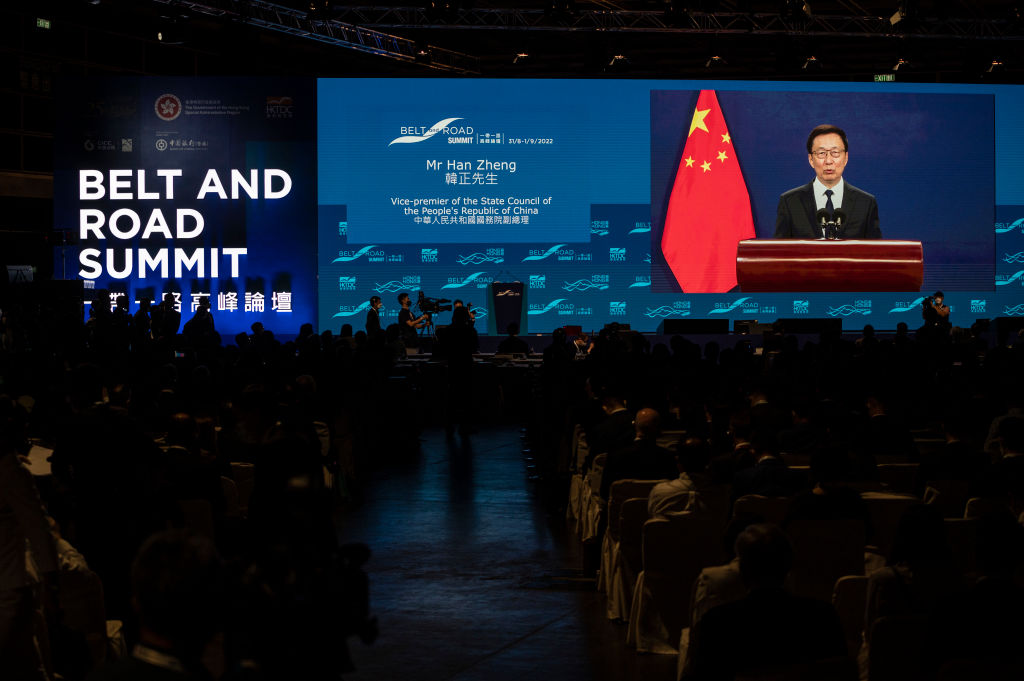
One of the challenges that historians face in the midst of global change is to encapsulate the exact moment when a new global order has replaced an old one. They often point to a period of change or crisis as the moment when an old order ended, but in those moments a new one has not yet replaced it. The world was already rattled by challenges such as climate change, financial crises, a pandemic, and rising inflation when Russia’s invasion of Ukraine on Feb. 24, 2022, triggered the transition away from the unipolar global order. The multilateral institutions charged with protecting and promoting the values of the liberal world order and ensuring respect for international borders have seemed to fail at responding to the complex challenges in recent years. The division between liberal democracies led by the United States and illiberal powers led by Russia and China in the wake of the Ukraine conflict is a sign of a newly emerging great power competition. One of the regions of the world that is increasingly becoming important in international politics is South Asia. The nations of this region are recalibrating their foreign policies in the face of this new global rivalry.
Nevertheless, they have already shown signs that they can and are willing to balance relations with global powers that have turned rivals, which is a necessity considering the diverse needs of the countries in this region. South Asia, especially India, is vital to the United States in checking Chinese influence in the Indo-Pacific region. This is because South Asia shares borders with China, and India is one of the rising powers that has the capability to resist China’s drive for influence in the region. What grand strategy the U.S. should adopt toward South Asia as a region is an issue that is worth exploring given the investments the U.S. is making in developing the Indo-Pacific region. Can it afford to limit development to the Quad and exclude other nations in South Asia?
Countries around the world have felt the economic costs of the Russia-Ukraine war because of the nature of the exports of both Ukraine and Russia. They together export nearly one-third of wheat and 70% of sunflower oil on the global market. Russian fertilizer is crucial for global food production. The trade embargo on Russian products disrupts the global energy and food supply chains, contributing to rising inflation in many countries worldwide. Europe is very much affected by the war because of its dependency on the Russian energy industry. It will be interesting to see whether European countries will be willing to continue the sanctions against Russia in 2023 too. The war and sanctions have seriously impacted South Asia. This is mainly because South Asia heavily relies on fossil fuels for energy generation, and also food supplies and fertilizers from both Russia and Ukraine.[1]
The Middle East was probably one of the regions where America’s allies first realized that they could no longer depend on the U.S. to defend them from threats and instability. Arab Gulf nations such as Saudi Arabia, the UAE, and Qatar intervened in conflicts in countries such as Libya, Syria, and Yemen in the context of the “Arab Spring” protests and ensuing civil wars. They did this to protect their interests, deter the increasing influence of Iran, and prevent Islamist parties from coming to power when they felt that the U.S. would no longer assume the full responsibility of containing Iran. U.S. allies in other parts of the world have also been revisiting their national security and economic strategy. Japan and South Korea are taking proactive steps to strengthen their self-defense capabilities without waiting for American security guarantees in the face of China’s belligerence and North Korea’s nuclear program. In Europe, Germany is moving ahead to increase its defense budget after resisting American demands to do the same for many decades.
All of these developments have led to opinions that the globalization project is under severe stress and that trust in the U.S.’ ability to manage it is diminishing, and suggest a change in the existing world order. But the question is: What is likely to be the nature of the new world order that will replace the old one? The possible multipolar system would encompass the entire globe, unlike the last multipolar global order of the 19th century, when European colonial powers were the major powers, having colonized almost the whole world. As Marc Saxer has pointed out, in the multipolar order nations would limit cooperation on issues such as human rights and promotion of democracy compared to the earlier liberal order, as they would not consider these issues vital to their national interests. At the same time, cooperation on an issue such as climate change is more possible in a limited multilateral framework, as most countries of the world have suffered its devastating consequences.[2] Unlike the Cold War, nations would also align with each other to oppose an adversary not on the basis of ideological affinity, but because they would see the adversary’s actions as a threat to their national interests.
The new multipolar global order would also be more complex in terms of the number of powers that would constitute the major players, as besides the major nations and blocs such as the U.S., China, India, and the EU at the global level, there would also be major players at the regional level such as Brazil, South Africa, Nigeria, Iran, Israel, Japan, and South Korea, making the balance of power a more complex system. But it would be very difficult to predict whether such a system would be more stable than the liberal world order, as the international system has become unpredictable due to the rise of a significant number of nonstate actors in the context of globalization. Besides, China is trying to promote an illiberal multilateral system led by it by pushing its Belt and Road Initiative (BRI) and the China-led Asian Infrastructure Investment Bank as an alternative to the Western-led financial organizations like the World Bank and IMF.[3] It is too early to say whether China’s attempts will turn out to be successful, as there are myriad factors that both positively and negatively impact the ultimate results. A factor that favors the Chinese model is its attractiveness to governments of nations in the Global South, as the model includes no demands for democratization or protection of human rights. On the other hand, there are increasing concerns, such as whether participation in the BRI results in a debt trap and economic crisis for nations. There are other concerns as well, such as the Chinese government’s crackdown on Chinese tech companies and the lack of open and critical debate on China in the Confucius Institutes established by China in various countries. This raises the question of whether a nation’s domestic policy comes under greater international critical scrutiny when it tries to promote its soft power and national image. Whether nations of the Global South will prefer joining a Chinese-led multilateral initiative over accepting Western assistance will depend on how well China manages its image and retains its credibility in the international community.

What strategies would South Asian countries adopt to survive in this period of global change? The countries in South Asia are economically dependent on the major powers of the globe, and are not exclusively linked to any one particular global power or economic bloc. India depends on Russia for armaments and spare parts for its military hardware. Most of its fighter aircrafts are also Russian. India has also received strong support from the former Soviet Union in times of crisis. In 1971, India aided the Mukti Bahini, who were fighting the Pakistan Army in what was then East Pakistan for the creation of Bangladesh. When the U.S. sent the 7th Fleet to the Bay of Bengal in support of Pakistan, the Soviets sent a naval task force, leading to the withdrawal of the Americans. Bangladesh itself has technological partnerships with Russia, including for the building of a nuclear-powered electricity generating plant. Bangladesh is also attracting investment from various countries, including Japan and China. With regard to Sri Lanka, the U.S. and EU are the biggest markets for Sri Lanka’s exports. Russia has continued to support Sri Lanka at international fora with regard to Sri Lanka’s track record on human rights, especially in its war against the LTTE. Sri Lanka became closer to China in the 10 years after the war ended in 2009, as it completed many new post-war infrastructure projects with Chinese loans.[4] But in the face of the economic crisis and political upheaval in Sri Lanka, the new government is showing signs that it intends to move away from close economic ties with China.
The Chinese see India as collaborating with the West to check their influence in South Asia. When it comes to smaller South Asian countries, it is a matter of balancing India and China. The situation in the Maldives is quite complex, as there are political factions in their domestic politics that alternately support India and China. Therefore, Maldivian domestic politics will decide its foreign policy. Shared borders means that China has considerable influence in Nepali domestic politics. Likewise, China has leverage over Bhutan to solve the two countries’ boundary problems in a manner favorable to China. While national interests would determine whether South Asian countries would be close to China, such countries that share borders with China would find it difficult to completely avoid its influence. Strategic mistakes on the part of India, which is sometimes seen as a “big brother” by smaller South Asian countries, could drive these countries toward China.
Pakistan’s situation is in a way different from the other South Asian countries, as it was clearly in the Western camp during the Cold War. It later allied with China when it realized that the latter could effectively counter India in South Asia. Pakistan managed to have strategic relations with both its patrons, the U.S. and China. But in any relation between patrons and clients, changes in the strategic requirements and goals of the patron can drastically alter its relations with its clients. The U.S. withdrawal from Afghanistan also brought about deteriorating ties with Pakistan. On the other hand, Pakistan grew closer to Russia due to Russia’s deepening relations with China, as well as taking advantage of lost momentum in India-Russia relations.[5] There was a political strand in Pakistan led by former Pakistani Prime Minister Imran Khan that increasingly wanted to maintain neutrality between the West on the one side and Russia and China on the other. But with his ouster due to the opposition of the Pakistan Army, which still favors the old alliance with the U.S., this thinking has lost its traction. It is doubtful that this change can lead to a warming of relations between the U.S. and Pakistan.
The South Asian countries have tried to balance relations with major powers by considering the varied economic and political relations that they have with these countries. This was the case even when India was getting very close to the U.S. in recent years. Even when India participated in the Quad, which is often described as an attempt to counter Chinese influence in the Indo-Pacific region, along with the U.S., Japan, and Australia, it refused to take part in the naval patrols of the Quad.[6] India was always reluctant to depict the Quad as an anti-China alliance. This was one of the reasons the U.S. formed the AUKUS, a trilateral security alliance between the U.S., the United Kingdom, and Australia, with a clearer mandate to counter China in the region. The outbreak of the war in Ukraine was an occasion when South Asian countries clearly were reluctant to join the West in openly taking a stand against Russia’s invasion. India, Pakistan, Bangladesh, and Sri Lanka abstained from the U.N. resolution condemning Russia’s invasion of Ukraine. India is clearly moving away from its policy of aligning itself closely with the U.S., which is the policy it followed in recent years in a situation where doing so could clearly harm its relations with Russia. But is India’s decision to balance relations with both the U.S. and Russia a return to the nonalignment of the Cold War years?
The present National Democratic Alliance coalition led by the Bharatiya Janata Party (BJP) that is in power in India is ideologically opposed to the nonalignment policy of the first prime minister of India, Jawaharlal Nehru, who was also the leader of the Indian National Congress. Since coming to power in 2014, the current Indian Prime Minister Narendra Modi has consistently skipped the Non-Aligned Movement summit meetings. Therefore, the current external affairs minister of India, S. Jaishankar, has termed India’s policy of maintaining relations with all the major powers in the world as “multi-alignment.”[7] India’s participation in both the Russia- and China-led Shanghai Cooperation Organization (SCO) and the Quad, which includes the U.S., provides an illustration of how this multialignment works. India’s participation in the SCO despite the presence of China, with which it has a border conflict, confirms the idea of “no limits in cooperation.” India’s profile is set to further increase as it is set to assume the presidency of the G-20 and the chair of the SCO.

The prioritization of certain parts of the world that are seen as more vital to the U.S.’ national interests complicate the country’s strategy toward South Asia. Michael O’Hanlon quotes George Kennan to list the regions that he considered important for American security, including Western Europe, Russia, and Japan. South Asia does not figure in this list. O’Hanlon suggests that the U.S. should follow a strategy of absolute restraint, where if China tries to grab territory, including in the South China Sea or Taiwan, the U.S. should not intervene directly. Instead, it should use indirect methods such as economic warfare and attacks on China-bound shipping in the Indian Ocean.[8] But such a method would be more effective if the U.S. had the military and diplomatic support of South Asian countries such as India. It is not just because India is useful as a bulwark against China that South Asia is important as a region. India is also one of the fastest growing economies in the world, which would not have been clearly envisaged during the time of George Kennan. South Asian countries will not respond positively to the U.S. strategy of putting pressure on them to join its political and economic efforts to isolate nations that challenge the liberal order, especially in the form of sanctions. This is because of the diverse political and economic relations that South Asian countries have developed to ensure their national interests, as mentioned earlier. The South Asian countries also do not have military relationships with the U.S., in which the latter’s troops would provide protection to them as they do in Europe or East Asia. Therefore, expecting these countries to adhere to America’s policies in the same way as members of NATO or Japan is unrealistic.
In a scenario in which the unipolar global order is on the verge of decline, it would be worthwhile for the U.S. not to expect South Asian countries to align with it on the basis of ideological affinity, but rather because it suits their respective national interests. Preventing the spread of Chinese influence in the region would be in the mutual interests of the U.S. and South Asian countries. But countries within the region also remain aware that China is a neighbor, and they would prefer using diplomacy to diffuse a crisis rather than use armed force. This is actually in line with the strategy of absolute restraint that O’Hanlon advocates. South Asian countries realize that the U.S.’ adversaries and rivals, such as Iran and China, are countries with which they will have to engage precisely because these two countries are important neighbors to the region. This will have to be strongly taken into consideration by the U.S. While it can be easily understood by the U.S. government, which engages in diplomacy with South Asian nations regularly, a more informed debate in political circles in the U.S. about what goes into the making of foreign policies in South Asia could result in more understanding from the U.S. Congress.
All of the countries in South Asia, especially Bangladesh, are drastically affected by climate change. This is another area in which the U.S. and South Asian countries can cooperate. The Biden administration’s steps to reverse the decisions of the Trump presidency to withdraw from the Paris Agreement, to continue to push for further reduction in carbon emissions, and to continue to fund climate adaptation programs in countries like Bangladesh can help the U.S. gain soft power in South Asia. The U.S. would also have to look for long-term changes in South Asia’s political and strategic scenario to build stronger relations with countries in the region. If Russia becomes more dependent on China, that could affect ties between Russia and India, leading to more robust relations between the U.S. and India. By exercising prudence and patience, the U.S. can ensure that there will be fruitful collaborations with countries in South Asia to face common challenges in a fast-changing global scenario relative to previous decades.
References
Implications of Russia’s Ukraine war on South Asia. (2022, April). CUTS International. Retrieved December 16, 2022, from https://cuts-citee.org/pdf/onw-2-2022.pdf
Jacques, M. (2022, April 11). India’s distancing from US over Ukraine crisis has deeper implications: Martin Jacques. Global Times. https://www.globaltimes.cn/page/202204/1259005.shtml
Jaishankar, S. (2020). The India way: Strategies for an uncertain world. HarperCollins.
Kugelman, M. (2022, February 24). What the Russia-Ukraine crisis means for South Asia. Foreign Policy. https://foreignpolicy.com/2022/02/24/russia-ukraine-invasion-india-pakistan-south-asia/.
O’Hanlon, M. E. (2021). A grand strategy of resolute restraint. Brookings. Retrieved December 16, 2022, from https://www.brookings.edu/blog/order-from-chaos/2021/05/24/a-grand-strategy-of-resolute-restraint/
Saxer, M. (2022, July 13). The end of the end of history. International Politics and Society (IPS). https://www.ips-journal.eu/topics/foreign-and-security-policy/the-end-of-the-end-of-history-6063/
War in Ukraine and its implications in South Asia. (2022). Economy Next. https://economynext.com/war-in-ukraine-and-its-implications-in-south-asia-92895/ Wuthnow, J. (2016). Posing problems without an alliance: China-Iran relations after the nuclear deal. National Defense
[1] Implications of Russia’s Ukraine war on South Asia. (2022, April). CUTS International. Retrieved December 16, 2022, from https://cuts-citee.org/pdf/onw-2-2022.pdf
[2] Saxer, M. (2022, July 13). The end of the end of history. International Politics and Society (IPS). https://www.ips-journal.eu/topics/foreign-and-security-policy/the-end-of-the-end-of-history-6063/
[3] Wuthnow, J. (2016). Posing problems without an alliance: China-Iran relations after the nuclear deal. National Defense University. https://inss.ndu.edu/Portals/68/Documents/stratforum/SF-290.pdf
[4] War in Ukraine and its implications in South Asia. (2022). Economy Next. https://economynext.com/war-in-ukraine-and-its-implications-in-south-asia-92895/
[5] Kugelman, M. (2022, February 24). What the Russia-Ukraine crisis means for South Asia. Foreign Policy. https://foreignpolicy.com/2022/02/24/russia-ukraine-invasion-india-pakistan-south-asia/.
[6] Jacques, M. (2022, April 11). India’s distancing from US over Ukraine crisis has deeper implications: Martin Jacques. Global Times. https://www.globaltimes.cn/page/202204/1259005.shtml
[7] Jaishankar, S. (2020). The India way: Strategies for an uncertain world. HarperCollins.
[8] O’Hanlon, M. E. (2021). A grand strategy of resolute restraint. Brookings. Retrieved December 16, 2022, from https://www.brookings.edu/blog/order-from-chaos/2021/05/24/a-grand-strategy-of-resolute-restraint/







